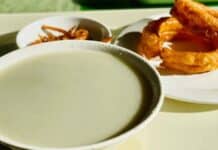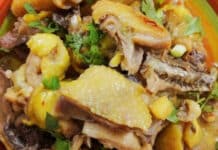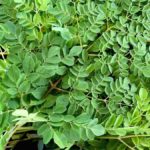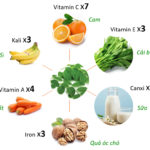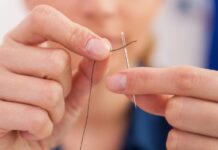Moringa Oleifera, commonly known as the Drumstick tree, is a versatile plant with a variety of names and uses. The tree’s young roots taste like horseradish, giving it the name “Horseradish tree.” Its straight, slender trunk and long, hanging fruit resemble a drumstick, hence the name “Drumstick tree.” The oil extracted from its seeds is also known as bel-oil.
+ Ecological Characteristics of the Drumstick Tree
The Drumstick tree is a small, woody tree. When left unpruned, it can grow up to 5-6 meters in height and 10 cm in diameter by its first year. At maturity (3-4 years old), its average height ranges from 5 to 10 meters.
The bark is thick and gray-white, with grooves that exude a gummy substance when cut. Over time, exposure to the environment turns this substance from white to reddish-brown or dark brown. The tree is thornless, and its leaves are bipinnate, growing to 30-60 cm in length with a bluish-green color. Each leaf has 6-9 pairs of leaflets that are 12-20 mm long and grow in opposite pairs.
The Drumstick tree’s flowers are white and resemble those of legumes. They bloom in clusters from April to June. The tree’s fruit is brown with a triangular cross-section and hangs downward. Each fruit is 30-50 cm long and 1.5-2.5 cm wide, containing at least 20 seeds. The seeds are typically dark or light brown, three-angled, and winged, with white membranes measuring 1.5-2.5 cm long and 1-1.4 cm wide.
+ Distribution
According to the “Vietnamese Herbal Dictionary” by Vo Van Chi (1996), the Drumstick tree is predominantly found in tropical and subtropical regions. In Vietnam, it is scattered throughout the southern provinces, including Da Nang, Quang Nam, Nha Trang, Phan Thiet, and Kien Giang (Phu Quoc).
+ Parts Used and Harvesting
- Parts Used: Fruit, roots, young leaves, flowers, and young branches
- Harvesting: Fruit is harvested from July to September. Leaves can be harvested year-round, and flowers bloom from April to June.
+ Chemical Composition
Each part of the Drumstick tree contains unique chemical compounds. For example:
- Bark: Contains gums (galactose, arabinose, and acid glucuronic), -sitosterol, and benzylanine.
- Roots: Contain glucosinolate compounds such as 4 (-L-rhamnosyloxy)-benzyl glucosinolate)
- Leaves: Rich in antioxidants such as flavonoids and phenolic compounds (kaempferol, gallic acid, kaempferol 3–O––rhamnoside, rutin, syringic acid, and quercetin 3–O– –glucoside). They also contain gums and two alkaloids: moringinin and moringi.
- Flowers: Polysaccharides are the primary chemical component found in the flowers.
- Seeds: Contain glucosinolate and peptide compounds
- Whole Plant: Pterygospermin is the primary chemical constituent.
Nutrition experts suggest that 1kg of Drumstick tree products can provide sufficient daily nutrition for a family of four. Among its parts, the leaves are considered the most nutritionally valuable. Comparatively, the tree’s leaves contain seven times more vitamin C than an orange, four times more vitamin A than carrots, and four times more calcium than milk.

Nutritional Value of the Drumstick Tree
Benefits of the Drumstick Tree
The nutritional value of the Drumstick tree has led scientists to uncover numerous health benefits associated with its consumption:
Cancer Prevention
Drumstick tree leaves are rich in zinc, vitamin C, antioxidants, and other compounds that combat cancer-causing agents and free radicals. They contain niazimicin, a compound that inhibits the growth of cancer cells.
Improved Metabolism and Immune System
The antioxidants, zinc, and vitamin C in the leaves enhance immune cell activity, strengthening the body’s defense against bacteria, viruses, and free radicals.
Cardiovascular Health
Regular and proper consumption of Drumstick tree products can contribute to a healthy heart. The high levels of antioxidants in the leaves have been shown to reduce cholesterol levels, thereby lowering the risk of cardiovascular diseases.
Liver Protection
Drumstick tree leaves contain silymarin, which improves liver enzyme function and protects the liver from damage caused by a high-fat diet.

Drumstick Tree Leaves Contain Silymarin for Liver Health
Blood Sugar Control
The Drumstick tree is well-known for its therapeutic benefits for diabetics. This effect is attributed to the isothiocyanates in the leaves, which help reduce blood sugar, protein, and glucose levels in urine.
Hypertension Reduction
Hypertension often occurs when arteries thicken. Compounds in the leaves, such as niazimicin and isothiocyanate, can prevent and reduce this condition.
Anemia Prevention
Drumstick tree leaves are recommended for anemia patients due to their high iron content. They contain significantly more iron than beef or other animal meats, with 100g of dried leaf powder providing 28mg of iron.
Beauty Benefits
In addition to its health benefits, the Drumstick tree is a valuable ally in skincare and beauty routines. Oil extracted from its seeds contains the hormone cytokinins, which helps maintain healthy, firm skin. The antioxidants and vitamin C in the leaves also protect the skin and slow down the aging process.
The Drumstick tree is a nutrient-rich addition to your diet for healthy skin and hair.
Proper Use of the Drumstick Tree
The Drumstick tree can be prepared in various ways:
Leaves: With a flavor similar to ngót leaves, they can be used as a vegetable in everyday meals. The leaves can also be eaten raw or blended into tasty smoothies. Alternatively, dry them thoroughly and grind them into a powder, which can be mixed with water for drinking or added to porridge or soup.
Flowers: Dry the flowers and brew them like tea.
Fruit: Cook the fruit in soups, bone broths, or stir-fries.
Precautions when Using the Drumstick Tree
Avoid prolonged continuous use: This herb is rich in vitamin C and calcium. Excessive long-term use may lead to an overdose of these nutrients, especially in young children. It is recommended to consume it no more than three times a week, with a maximum of 20-30g per serving.
Do not consume in the evening: For individuals with a history of insomnia, it is best to avoid evening consumption as it may disrupt sleep.
Not suitable for pregnant women: The Drumstick tree contains alpha-1-sitosterol, which causes uterine contractions. Pregnant women who consume it are at risk of miscarriage.

Pregnant Women Should Avoid the Drumstick Tree
Avoid overcooking: To retain the maximum nutritional value, cook the leaves moderately without overdoing it.
With over 15 years of experience in web design and development, I have helped hundreds of businesses create comprehensive web development plans to ensure sustainable growth and profitability from their websites.
The Ultimate Superfood: This Vegetable Rivals Bird’s Nest in Nutrition, Packing 4 Times More Calcium Than Milk, Yet It Only Costs $0.20 a Bunch at the Market
“Moringa oleifera, also known as the drumstick tree, is a nutritional powerhouse packed with an impressive array of vitamins, minerals, and antioxidants. The leaves, in particular, are a rich source of zinc and vitamin C, which have been scientifically proven to combat certain cancer-causing agents. This humble leaf boasts a unique combination of nutrients that set it apart from any other plant, making it a true superstar in the world of natural medicine and wellness.”












